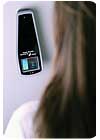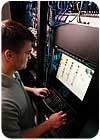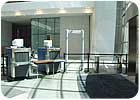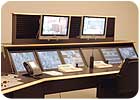
Designing and installing integrated IP-based security systems is a big job. To find installations of such systems,SDMsought out some of the largest security dealers and systems integrators in the industry. Some are even manufacturers of systems who are functioning as installers, lead technology contractors or project managers who subcontract work to their authorized dealers because of the scale of the projects.
As the scale and degree of IP-based security increases, the reluctance to discuss it grows, especially with government agencies. Although some large IP-based security installations were reluctant to be identified for security purposes, they agreed to allow details of the installations to be divulged to their colleagues in the industry who readSDM, without identifying the location.
One integrator uses his offices not only to offer his central station customers high security but also to demonstrate to customers the state-of-the-art in access, video, facial recognition and ID badging technology and show how effectively it works. Another major manufacturer is using the fourth largest airport in the world as a beta-testing site to develop new integrations of IP-based security equipment.
In each case, the dealer/integrators have found ways to provide their customers with new solutions and systems only possible or practical with IP technology.

The vision access reader recognizes Catherine Bartlett, marketing communications manager of Infrastruct Security Inc., Houston, based on the scan of her it has in its memory. Scans are taken of all visitors’ faces at the reception desk before they enter areas with increased security.
Security at Four Levels
Because seeing is believing, Infrastruct Security Inc., Houston, has installed integrated IP-based video, access and facial recognition systems at its new central station facility.“The little secret in our business is that oftentimes the security at the security companies is poor,” maintains Daniel Weiss, Infrastruct’s president and CEO. He compares it to the building contractor who lives in a shack because he’s too busy building other people’s houses to build himself one.
“We take our security posture here very seriously, because we service a niche,” Weiss emphasizes. “We’re in a vertical that we really define as more of the high-end, regulated security segments.” These include financial, petrochemical and wastewater and fresh water treatment markets.
“When you represent a high-end vertical, if a guy comes into my office, my security has to be the best — I have to wow the customer when they walk in here,” he stresses. “A lot of times customers don’t need the highest security level, but if you show them and demonstrate it to them visually, where they can sit down and see it, they’re much more likely to make the selection.
“If we get someone into our demo room, our closing ratio is great, and we always sell one of the more premium brands,” Weiss asserts.

Bobby Richter, market researcher, operates the intelligent video management system in the IT room at the offices of Infrastruct Security Inc., Houston.
The second level of security is in the company’s sales department and general office area. The visitor’s access card is required to enter this area. Networked video cameras keep tabs on this area and are located throughout the entire facility.
Individual offices, the operations area, equipment storage, bench testing and office supplies are at level three security, which requires passage through another set of access devices.
At level four is the IT, security and telecom room and the central station itself. Visitors must proceed through a mantrap to reach the central station and match the facial recognition image that was taken in the reception area.
“We don’t just want to gather more information,” points out Weiss. “We want to gather usable segments of information outside the standard norms and pay attention to that. If you just keep dumping data, no one pays attention to it.”
The system identifies the faces that pass by the video surveillance cameras. “If one of those faces doesn’t belong, it puts a red box around it, and it can alert me that there’s a problem,” Weiss explains. “All this goes through servers and is distributed throughout the office.

A reader that uses both hand geometry and finger scanning provides access to higher security areas of the offices.
“It used to be that we were in [meetings] with the CIO and CSO and security guy,” he says. “A lot of times the security guy is not even there anymore. So if you don’t learn how to talk IT, you’re going to be relegated to light retail and the home alarm markets.”
That infrastructure division helps Infrastruct sell its jobs, too. “Here at my office, we did the entire thing ourselves,” Weiss emphasizes. “So we do everything for the client. We put in the entire infrastructure system — all the cabling, patch panels, racks and put in all the security equipment and racks.

Jay Craig (left), A/R manager, and James Campbell, CFO, comment on the operation of the PTZ IP cameras throughout the accounting department at Infrastruct Security Inc., Houston.
Weiss gives the example of a recent job Infrastruct won to put video surveillance in a parking lot. Competitors using conventional surveillance systems needed to do sawcuts in the lot to install cabling.
“They had a network going through the buildings, so we said the way you do this is wireless IP PTZs, and we can knock out $50,000 in waste and expense and improve the quality of the video,” Weiss insists. “The competitors tried to convince the customer that those products aren’t that great, that they’re untested.”
That’s when Infrastruct’s equipment demonstration paid off. “We demonstrated in our office, put a PTZ on our roof,” Weiss remembers. “They flew in guys from California to see this office. We took wireless PTZ, zoomed in and were reading license plates on the freeway.

Donna Kerr, service manager at Infrastruct Security Inc., Houston, uses the scramble pad reader in the main lobby.
Fear of new equipment and systems has dogged dealers and integrators before, Weiss remembers. “It reminds me of when I got into the alarm business, when all the guys were scared to do cameras,” he recalls. “It’s the same thing now. They say, ‘I don’t want to mess around with IT stuff, it’s too complicated.’
“It’s not that complicated to do, but you have to make the investment and have IT guys who understand it,” Weiss insists. “You can sell more, deliver a better product to customers and differentiate yourself more.”

Metal detectors employed at entrances not only sense metallic objects but also show on a monitor where those objects are hidden.
All ‘Senses’ on Alert at Gov’t Agency
Highly sophisticated, integrated IP-based security systems are in demand at many government facilities in the market region of AccuTech Systems Inc., Rockville, Md.For a government agency, the company linked three buildings separated by up to 30 miles through a single operations center that integrates video surveillance, access control, ID badging, metal and chemical detection and vehicle entry through an IP-based security system.
More than 200 cameras and more than 200 proximity smart card readers were installed as part of the project.
The video system is located at the central operations center. “It’s just one big recording platform using a RAID configuration, so the positives are if you lose some video, the RAID will rebuild themselves,” explains John Bellistri, AccuTech’s senior account manager.
The access control system has hard redundant servers with the main server at the operations center. “Everything is operating on one domain, so there is one control location for both sites,” Bellistri explains.
“We changed out the standard prox readers to smart card readers, but we had to keep the database,” he reports. This required much database conversion work. “Basically, all the employees have new credentials.”

The central operations center integrates video surveillance, access control, ID badging, metal and chemical detection and vehicle entry for three government buildings through an IP-based security system.
“They just wave their credentials at the proximity verification reader, and it gives them a green light, so the guard knows it’s a good read and they’re an employee,” Bellistri explains. ID badging for visitors also is provided with the access system, which is quicker and less expensive than turnstiles, he asserts.
Barrier-style turnstiles are used at the headquarters’ lobbies because their size allowed installation of this entry solution. It also was necessary because many visitors are processed at this location.
The access panels were put on the agency’s computer network and configured with existing routers and servers.
Video surveillance is motion-activated and integrated with access control. “If someone enters an area and the alarm goes off, the access system is integrated with the DVR, so that they can pull up clips associated with the alarm condition,” he explains. “Right away, you’re able to see that video clip of what happened, rather than having to go to the DVR to access the video.”

Barrier-style turnstiles were installed at the headquarters’ lobbies because many visitors are processed at these locations.
“If you had a knife in your sock, it would pinpoint where that metal is, so if something happened, the guard would know some metal is associated with your ankle,” he continues. “It’s a little more sophisticated than the typical metal detector.”
The metal detection information also is integrated with the video surveillance system so the incident is recorded on video.
At the operations center, parking control for employees was recently installed with 19-foot barrier arm gates and integrated with the security system. Employees’ smart cards activate the gate.
“Depending on the threat level, we can raise and lower the barrier arms to restrict vehicle entrance into the facility,” he notes. The gate also can be controlled from the facility’s guard house.
One of the buildings has an ion mobility spectrometer (IMS) integrated with the security and air handling systems. If any of 16 chemical warfare agents is detected by the IMS, certain air handlers could be shut down and the access control system notified. “It’s a one-of-a-kind system,” Bellistri maintains.

The ground-based radar system provides long-range detection that extends beyond the perimeter of the airport.
Pulse-based Tracking System Follows Airport Targets
For upgrading security to IP-based systems at three airports in the metropolitan area of Houston, the airport system needed an integrator that could reach across all types of security systems and had wide-ranging experience.Having that integrator be a manufacturer with a wide-ranging product line that included all security technologies made the job that much easier for Mark Mancuso, deputy director of public safety and technology for the Houston Airport System, Houston.
Finally, for that integrator/manufacturer to be able to use the airport for beta-testing of new products resulted in a win-win for all parties.
One portion of the two-year project nearing completion is the installation at George Bush Intercontinental and William P. Hobby airports in Houston of radar video surveillance (RVS) systems. These track ground-based moving targets using pulse-based rather than Doppler radar.
“Doppler would be better in other locations — it depends on the terrain and site-specific needs,” Mancuso explains.
Working with the airport authority has been Honeywell Security, Louisville, Ky., which employs its authorized dealers and integrators in the region on different areas of the project, some of which is financed through a multimillion-dollar grant from the Department of Homeland Security.
“We took a look at quite a few technologies, but were unable to find any integrators of the substantial size we needed,” Mancuso asserts. “I was focused on trying to limit the number of contact points we had to have. Having dealt with technology in the past, occasionally there’s a little finger-pointing that goes on when something doesn’t work.

George Bush Intercontinental Airport in Houston has radar and video surveillance systems integrated to protect its 10,000 acres and perimeter 34 miles in circumference.
Jeremy Howard, Honeywell’s global accounts aviation and seaport manager, agrees. “We found as we continue to develop our airport space that many airports are requesting and demanding direct relationships with large-name companies like Honeywell,” Howard explains. “So in Houston, we entered into a strategic partnership where Honeywell subcontracts back to authorized dealers but maintains our project management functions.
“That overall process for us, because it’s new and not traditional, has been somewhat of a change, because we’re not trained in the construction business,” he asserts. “It’s been a bit of a challenge, but I think we’ve come a long way, and at the end of the day, we have a satisfied client.”
Among the Honeywell authorized dealers working on aspects of the airport project are NetVersant Solutions Inc., Houston, and Pref-Tech (Preferred Technologies) Inc., Houston.
“We had four or five different authorized dealers bid the project, and Honeywell as prime contractor chose the best value based on price, scope, experience with the airport and how they proposed implementing the system,” Howard explains.
NetVersant had done work at the airport before. The airports already had Honeywell’s Pro-Watch integrated security management platform installed, and Mancuso was familiar with it.
“So we took a look at the product offerings by the major integrators out there and decided Honeywell had the best line of products for us,” Mancuso explains. “Since the airport had already purchased Pro-Watch and was using it, it made sense to continue on with that product line.

This long-range thermal imager/PTZ camera at the airport communicates with the security forces center/desk via wireless.
The next point of protection is perimeter fencing that includes an early-warning intrusion detection system with the ability to track targets.
“The new frontier for airport security, where a lot of the focus and money is being addressed, is at the perimeter,” maintains Howard. “Airports have done a fairly good job of securing the interior terminals, but as we’ve progressed, we’ve noticed more and more vulnerabilities exist at the perimeter.”
Adds Mancuso, “What we crafted was a system of ground-based radars strategically located to give coverage throughout the perimeter of the airport with overlapping coverage and the ability to track multiple targets at once.” The radar system had been developed by Honeywell Aerospace to track missiles.
“Coupled with that are long-range thermal imaging cameras so we can monitor the perimeter in daylight and dark and in all weather conditions,” he notes. “Thermal imaging cameras would do the best job for us under those circumstances.”
“That by far has been our biggest technical challenge, and we’re wrapping that up now,” Howard relates. “From what I can tell, it’s been a success.”
Video analytics create a virtual perimeter outside the fence line so cameras can view an incident as it occurs. In the event an intrusion is detected by the radar, the operator is alerted and can zoom the surveillance video cameras in the area on the target itself.
“Very sophisticated, long-range thermal and color cameras are installed, so they can assess the situation at night versus daytime,” Howard notes. “It could be a deer or a person or a vehicle unauthorized to be there, and from that, they mobilize whomever they need to intercept that target.”
A geospatial map of the airport comes up on the security system and the intruder can be seen on the map. “It looks like a red dot moving around the airfield,” Howard explains. The intercepting vehicle also can appear on the map.
“On the same geospatial map, a green blip could represent a security vehicle, so they would know where they are on the airfield at all times, not just to identify potential intruders, but also to be used ultimately to track and better deploy vehicles that might be security- or fire-related,” Howard says.
The next systems scheduled for installation at the Bush airport are 500 additional CCTV cameras to total 1,500 at the airport and other video analytic technologies.
The goal is for the third-party, IP-based product to identify a person that has broken a security checkpoint in the airport and use different algorithms to track that person through the airport and find him or her within 30 to 60 seconds.
“The benefit to everybody here is they’re able to use the fourth largest airport as a laboratory to see how these products really work in a large-scale operation,” points out Mancuso. “To have access to this kind of environment to see what’s involved in the technology is pretty important.”
Adds Howard, “We’re overcoming integration challenges everyday. It never really ends.”
Sidebar:On the Job
Head End- 1 Hirsch Velocity 2.6 with visitor manager
- 2 M8 Hirsch access control panels
- 1 A4 Vision facial recognition access control system
- 1 Video Insight 16-channel DVR
- 1 3VR 1600i 16-channel video facial recognition (analytics) intelligent video management
- 1 DSC Maxsys intrusion panel
- 1 Hand Key II palm reader (biometric)
- 1 Bioscrypt thumb reader (biometric)
- 3 Hirsch scramble pad readers
- 8 HID readers
- 1 A4 Vision facial recognition access control system
- 1 Vision facial recognition reader by A4 Vision
- 2 Panasonic PTZ interior cameras
- 7 Fixed interior dome cameras
- 4 Fixed exterior cameras
- 1 Exterior PTZ camera
Sidebar: On the Job
- Pelco 9760 matrix switcher
- Pelco Spectra III pan-tilt-zoom cameras
- Integral Technologies Digital Sentry 192-channel DVR
- Hirsch Velocity access control
- HID smart card readers
- Designed Security Inc. barrier turnstiles
- View Systems metal detectors
- Big Systems guard house
- Drager ion mobility spectrometer
Sidebar: On the Job
End-to-end video surveillance, access control systems and IP technology solutions:- Perimeter camera deployment strategy
- 24/7 surveillance via infrared fixed and PTZ cameras
- Fixed detection cameras, PTZ assessment cameras
- Denoising
- Image stabilization
- Tamper detection
- Integration of PTZ with tactical radar
- Back-end analytics
- Low false alarm rate object motion detection
- Object tracking and classification
- Tracking people camera to camera
- Approximately 1,500 card readers
- PW-5000 access control panels
- Pro-Watch and Pro-Watch AP
- Upgrade to include over 1,500 fixed and PTZ cameras
- Digital Video Manager (integrated with Pro-Watch and RVS)
- All standard video transferred to Ethernet via streamers